
How Do I Get Tickets?

This question comes in a variety of forms. Most commonly something like "I'm planning a trip to Japan and want to buy tickets via the Internet before I go. How can I do that?"
For 9 years, I helped people get to baseball games in Japan with JapanBallTickets.com. However, a person within the Giants organization decided that he could rise up the ranks by shutting down services that "resold" tickets. Despite explaining that I purchased tickets on customers' behalf and charged for my time, he, four teams, and a representative from NPB did not see it that way. So we were shut down. I've now returned to programming full time, which is a lot less stressful.
Anyway, I still want to help, but may only do so in a very "hands off" approach. So below are resources for you to purchase tickets yourself.
Central League
- Tigers / Koshien High School (Osaka/Kyoto)
- Carp (Hiroshima): international_question@carp.co.jp
- BayStars (hour south of Tokyo)
- Giants (Tokyo): giants_info@giants.co.jp
- Swallows (Tokyo)
- Dragons (Nagoya): dra-fan-info@pia.co.jp
- Buffaloes (Osaka/Kyoto): info@orixbuffaloes.jp
- Marines (hour east of Tokyo): Contact Form
- Hawks (Fukuoka)
- Eagles (Sendai): Contact Form
- Lions (hour west of Tokyo)
- Fighters (Sapporo)
Nippon Professional Baseball [Contact: npb_info@npb.or.jp] manages ticketing for the All-Star Games and Nippon Series each year. Please inquire with them how you can get tickets for those events. (And if you wanted to suggest that they hire me to head up a division in charge of helping visitors get to games, I wouldn't object.)
Also, I have the 2025 schedule/fixtures in a spreadsheet here.
If you want to see the Carp or Tigers, they both put their entire season of games on sale at the end of February or beginning of March. Other teams generally put tickets on sale 4-8 weeks in advance of a given week of games. So you'll need to mark your calendars to monitor the above ticketing sites appropriately. I'm filling in sales starting dates as they are announced in the above spreadsheet.
Hope this helps you get prepared for a great trip!
Notoriously difficult tickets to get on game day include most Giants', Tigers', Carp, and Hawks games (home and away - especially on Fridays and weekends) and games on big national holidays (Golden Week (April 29th to May 5th) - Childrens' Day (May 5th) in particular). Increasingly in 2015, weekend and holiday games for all teams have become difficult, especially for the better seats.
Oh, and some of the teams have special give-away nights that sell out in no time. And these are for a Tuesday through Thursday series. I've been caught completely off guard by these a number of times, wondering, "Why is this match-up sold out?" So it could happen at any time.
The version of the question that often isn't asked, but should be, is "How do I get to a game (and buy tickets there)?"
The best answer to this was put up by Latham-san on his See a Game page. Unfortunately, since the time the site was last updated, Nippon Ham moved to Hokkaido, Orix and Kintetsu merged, Rakuten became a new franchise in Sendai, and the Hawks were sold to SoftBank. Fortunately, Sapporo Dome and Miyagi Stadium are the only two stadiums not included.
Latham-san has since moved out of Japan, and his site had acutally disappeard for a short time. But due to a suspected error on the part of his ISP, his older site has gotten restored. Before it disappears again, I will recreate what he had below. (Latham-san, if you stumble across this and have any objections to my use of your work, I'll take it down - just ask.)
As an aside, despite the datedness of his site, his See a Game page is still a must read for anyone heading to Japan to watch a game for their first time.
Getting on the right track: From Nagoya Station, take the Chuo Main Line and get off four stops later at Ozone. From there, follow the map on this page. Nagoya Dome is about a fifteen minute walk from Ozone Station.
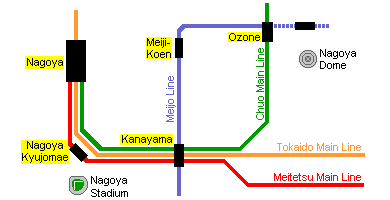
Incidentally, two new subway stations near Nagoya Dome are currently under construction [in 1999 - does anyone have an update?].
Update: The Meijo Line has been extended and now lets out just outside of Nagoya Dome. (Thank you Bavasi-san for the update.)
Surrounding area: Don't plan on staying around Ozone after the game. You won't find anything of particular interest in the surrounding area, unless you consider smokestacks and industrial parks interesting.
Around Nagoya Dome:
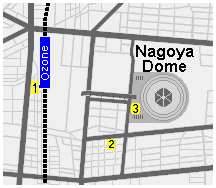
Convenience store (with alcohol)
OK convenience store
Nagoya Dome ticket booth, gift shop, and fast food booth
Because of high prices at the dome, you may wish to pick up snacks elsewhere before the game. While there are three convenience stores near the dome (see map), the best place to pick up fast food is at Nagoya Station. There is a Subway Sandwiches, McDonalds, and several other junk food establishments nearby.
Unfortunately, Nagoya Dome has a policy forbidding fans from bringing food and beverages with them to a game. Bags are searched, albeit with the least possible effort. If you plan on smuggling your snacks, bury them at the bottom of your backpack.
Buying tickets: Tickets for Nagoya Dome, among the most expensive in Japan, are for sale at the booth near the front of the ballpark. The cheap seats run 1,600 yen, while the best ones (aside from luxury seats) cost between 4,500 and 5,500 yen. Because of the dome's novelty, Chunichi games sell out fast [circa 1999]. It's a good idea to either get tickets well before the day of the game. Otherwise, you'll likely have to buy them from the scalpers around the front of the ballpark who usually sell 5,500 tickets for twice their value and cheap seats (listed at 1,500 yen) for 7,000 yen.
The easiest way to get to Koshien Stadium is to take the Hanshin Dentetsu Line, which starts at Osaka-Umeda Station and goes to Kobe. Get off at Koshien Station and walk under the overpass. The ballpark is about a one-minute stroll from the station.
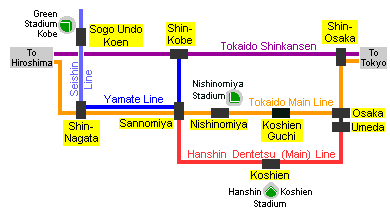
A less convenient way is to take the Tokaido Main Line, which connects Osaka and Kobe stations, to Koshien-guchi Station. But since that stop is about fifteen to twenty blocks from the ballpark, you'll likely have to take a bus or taxi the rest of the way.
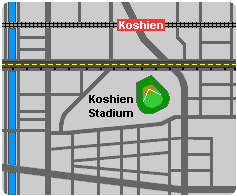
Look for the bust of Babe Ruth outside the front of the ballpark (he played an exhibition game at Koshien in 1934), and buy your tickets nearby.
Around the ballpark there are tennis courts, a few bowling alley and several izakayas (Japanese-style bars) decked out in Tigers decor.
Along the Tokaido Line, you can also stop by Nishinomiya Stadium by getting off at Nishinomiya Station. The home of the Hankyu Braves (BlueWave) until 1990, Nishinomiya occasionally hosts Hanshin and Orix games.
[Note: The following is for the old Hiroshima Shimin Kyujyo which will soon be demolished (Spring 2011). Is there anyone who can update this for the new Mazda Zoom-Zoom Stadium? Please write me.]
Getting there: Since Hiroshima has no subway system to speak of, there are basically three ways to get from Hiroshima Station to the ballpark. The least frustrating way is simply to grab a taxi, and tell the driver, "Hiroshima Kyujo, Onegaishimasu."
Hiroshima does have a street car system, and the main terminal is just outside the station. For a few hundred yen, get on the trolley (either the number 2 or 6 Miyajima tram) headed for either Hiroshima Municipal Stadium, the Genbaku Domu (A-bomb Dome). [Editor's note: I've heard that all or some of the trolleys have been retired. Can anyone confirm or deny that?]
The third and least recommended option is to walk. Either use the map on this page or a guidebook. It should take about twenty-five to thirty minutes to reach the ballpark.
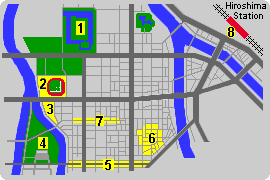
- Hiroshima Castle
- Hiroshima Stadium
- A-bomb Dome
- Peace Memorial Park
- Heiwa-dori (Peace Blvd.)
- Entertainment district
- Hon-dori Arcade
- Hiroshima Station
Around the ballpark: Most travelers don't visit Hiroshima to watch the Carp. Instead, tourists usually flock to the A-bomb memorial across the street from Hiroshima Stadium. Besides the Genbaku (A-bomb) Dome, Peace Memorial Park includes the Korean A-bomb and Children's Peace Memorial and the Peace Flame. A few blocks north lay the remnants of Hiroshima-jo Castle.
To the east of Peace Memorial Park lies the rebuilt city center, including Heiwa Dori (Peace Boulevard), the Shintenchi and Nagarekawa entertainment districts, and the Hon-Dori Arcade, a shopping district which includes several restaurants and fast-food joints.
The Swallows home ballpark lies within a large sports complex, containing a rugby field, soccer stadium, tennis courts and other attractions. On weekends, the streets behind the ballpark are sometimes closed to traffic and open to bicyclists and roller-blade hockey enthusiasts. It's a very pleasant and green area.
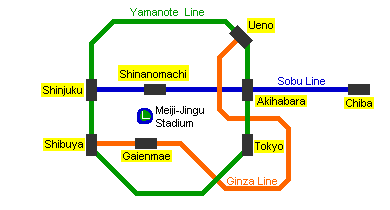
By train, there are two ways to get to Jingu Stadium. Probably the best is to arrive at Gaienmae Station on the Ginza line (which connects to Shibuya and Ueno). Around Gaienmae, there are a couple fast food restaurants (First Kitchen and Subway) and some convenience stores where you can pick up snacks for the game. If you take the road that leads to the front of the ballpark, you'll find several street vendors selling drinks and Japanese food. The back way is a nicer walk, and it's also where fans line-up to grab outfield unreserved seats (but get your tickets before you get in line).
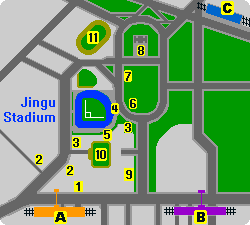
- Gaienmae Station
- Aoyama-itchome Station
- Shinanomachi Station
- Kinkos
- Convenience stores
- Restrooms
- Ticket booth
- Yakult clubhouse
- Yakult practice field
- Batting cages
- Picture Gallery
- Outdoor cafe
- Rugby Stadium
- National Stadium
If you get off at Shinanomachi Station on the JR Sobu Line (connects to Shinjuku and Akihabara), it's a pleasant stroll through one of the greenest areas in Tokyo before you arrive at the back of Jingu. You can buy infield tickets at the booth at the front of the stadium, and outfield tickets are sold behind the ballpark. With unreserved seats, it's a good idea to get to the ballpark a few hours early (especially if you plan to see a Giants game).
Between the back of Jingu and the Meiji Memorial Picture Gallery is a large practice field where the Swallows usually warm up before games. At the north-west corner of the field, there are coin-operated batting cages and a pitching machine where you can test your own ability.
From about 4:00 to 5:00 PM (all Yakult games at Jingu start at 6:20), players wander from the practice field, cross the street, and walk into the team's clubhouse (located outside the stadium, nearest the right-field foul pole). If you'd like to get an autograph or your favorite player's picture, this is the place to be.
Yokohama Stadium--a bland uninspiring ballpark perfectly suited for the team that calls it home. Fortunately, as if to compensate, it lies in one of the best locations in Japan.
While leaving either Yokohama Subway Kannai or JR Kannai Stations, one of the first things you may not even notice are the sidewalks--wide, straight, and not a piece of trash or splatter of vomit upon them. From either station, walk two blocks and you reach the stadium.
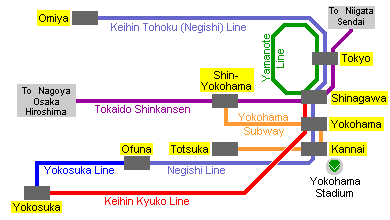
You can buy outfield unreserved tickets at the booth located on the north side of the stadium. For reserved seats, go up the ramp on the east side of the bowl, and get in line. Although the BayStars are a second division team (they very rarely compete for the Central League pennant), it may be a good idea to get your tickets a few hours before the game begins.
Adjacent to the stadium is Yokohama Park, a small and pleasant green oasis which sometimes offers flower exhibitions and other attractions. Walk about five blocks east, and you'll find the waterfront and Yamashita Park, a great place to watch the ships and ferries enter and leave the bay, or to see an occasional fireworks display.
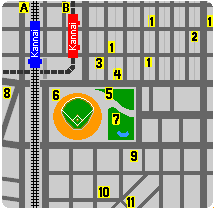
- JR Kannai Station
- Subway Station
- [Need to add Minato Mirai Line station]
- Convenience stores
- Liquor store
- Royal Host (diner)
- Convenience store
- Public restroom
- Yokohama Stadium
- Yokohama Park
- McDonalds
- Flashback Cafe
- The Pub
- Chinatown
About three blocks south-east of Yokohama Park is a modest Chinatown. I strongly recommend grabbing a few nikuman (a steam baked roll with a spicy meat and vegetable center) from one of the street vendors along the sidewalks.
If western-style food is your preference, there's a McDonalds near JR Kannai Station and a KFC inside the stadium, behind third base. Feel free to bring your own food and beverages to the stadium, but leave the glass containers at home. Even aluminum cans (potential projectiles for disappointed fans) are frowned upon.
After the game, if you feel like having a round of drinks, there are plenty of comfortable watering holes nearby. At the southeast corner of Yokohama Park, you'll find the cozy Flashback Cafe. Decked with Rock 'n Roll motifs, the cafe offers a wide menu of drinks and light western meals at reasonable prices. For those with more anglophile inclinations, try The Pub, a tavern two blocks south of the ballpark, which offers drinks and food in a British atmosphere.
If you feel like stretching your legs after a game, why not walk ten blocks north to Landmark Tower Plaza in Sakuragicho? You'll find fast food (Beckers, Wendys, McDonalds), some very expensive Japanese restaurants and bars, and the always moderately-priced Sizzler. Instead of walking, you can also take either the Yokohama Subway or the Keihin Tohoku line North one stop to get to Sakuragicho. Near Landmark Tower is Queens Tower which houses the Yokohama branch of the Hard Rock Cafe.
Or go directly to Yokohama Station. In the surrounding area, you'll find all kinds of restaurants and bars. From Mexican food like El Torito and Stoves to Japan's most popular chain of Italian restaurants, Cappriciosa, there are plenty of after-the-ball game places to go.
Located three stops from Ikebukuro via the Marunouchi Subway line, and between Shinjuku and Akihabara on the JR Sobu (Chuo) line, Tokyo Dome is within easy reach of all parts of Japan's largest city.
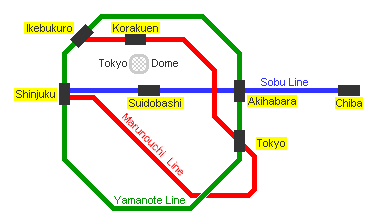
The closest station, Korakuen on the Marunouchi line, lies just across the street from the north side of Tokyo Dome. If you have time before the game, grab a burger at the McDonalds next to the subway ticket gates. Or stroll across the other street at the intersection and blow a few thousand yen at Yomiuri Land, the K-mart blue-light-special of amusement parks.
Leaving JR Suidobashi Station two blocks south of the dome, you will encounter several street vendors selling beer and soft drinks. Others peddle soba, udon, yakitori and other less easily identified morsels.
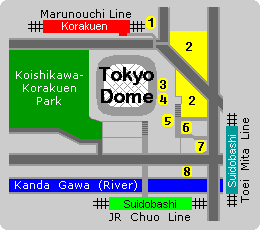
- McDonalds
- Yomiuri-Land
- To:Do gift shop
- Japanese Baseball Hall of FameMuseum
- Ticket booth
- Baseball Cafe
- KFC, Pizza Hut, Dunkin Donuts and Mr. Donuts
- Subway Sandwiches
If playing Japanese snack roulette disagrees with your palate, you'll likely find more familiar offerings at the intersection between JR Suidobashi Station and Tokyo Dome, a place which could easily be dubbed "fast food corner." There, you'll find Mr. Donuts, Dunkin Donuts, KFC, Pizza Hut, and Subway Sandwiches.
Those preferring quality over quantity should stop by the Baseball Cafe, immediately south-east and down one flight of stairs from the dome. While they don't offer Dodger Dogs, you can order burgers and other typically American dishes, all at a reasonable-for-Tokyo price.
If you still have time to kill and cash to throw around, visit the To:Do gift shop on the dome's east side. Although the emphasis is clearly on Giants merchandise, a bald eye will eventually land upon a few items relating to the dome's other tenants, the Fighters. [The Fighters had since moved to Hokkaido.]
Buy a cap, a T-shirt, and a plastic megaphone and get ready to cheer like the natives. For those who either have trouble sitting on hard seats for three hours or who wish to show their respect for the current Giants manager, why not purchase a Shigeo Nagashima [dated 1999] butt-pillow and reverently sit on the great one's grinning image?
Next to To:Do, past a 450 yen ticket counter and down one of level of stairs, you can enter the Japanese Baseball Hall of Fame bunker. Technically a museum, loosely defined, the lack of windows, the dull carpet and white walls and the lack of creativity in displaying the items conspire to lend this hall the personality of Astroturf. Clearly this attraction was included only as an architectural afterthought, an attempt to make use of empty space in the bowels of Japan's first dome.
Still for the price of a Big Mac, it may be worth a look. Team uniforms, pictures, cards and other memorabilia fill a long procession of glass cases, while one room contains plaques of all the members of the Japan Hall of Fame. Be aware, however, that virtually nothing is in English, so you had better either study the language or bring with you someone who reads Japanese.
If you haven't yet bought a ticket, stop by one of the booths either at the south-east, east, or north sides of the dome. Then look for your gate and get in line.
Before entering, you may be asked to open your backpack for inspection. You may bring cameras, food and drinks with you--but no glass containers. If you have canned beverages, you may be asked to pour the contents into paper cups.
Although a modest amount of parking is available, it's a good idea to go to Fukuoka Dome by train. From Hakata, Fukuoka's main rail terminal, take the Kuko Subway to Tojinmachi Station. It's about a ten minute walk to the Hawks' home ballpark.
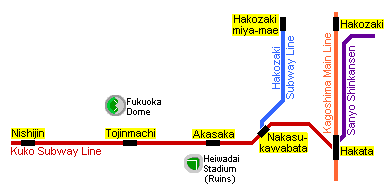
Surrounding the dome is Hawks Town, an area with several high-priced attractions. On the bay-side of the dome, there's a man-made beach while the Sea Hawk Hotel and Resort, a towering building shaped-like the hull of a ship, is linked to the dome by a shopping mall. A ten-minute walk east takes you to Fukuoka Tower, a sight-seeing perch which is open to the public for a small fee.
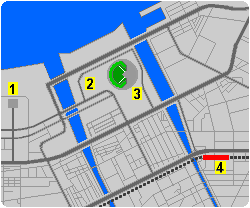
- Fukuoka Tower
- Sea Hawk hotel and resort
- Fukuoka Yahoo Dome
- Tojinmachi Station (Kuko Subway line)
Near Nishijin Station, one subway stop west of Tojinmachi, you'll find Jo-man temple, one of the few traditional attractions in the area. Southwest of Tojinmachi is Obori Park which contains the ruins of both Fukuoka Castle and Heiwadai Stadium, home of the Hawks from 1989-92 and the Lions (1950-78).
Getting on the right track: Probably the easiest way to get to Chiba Marine stadium is by taking the JR Sobu Line to Makuhari-Hongo Station. Leaving through the south (or west) exit, take the number 1 bus to Marine Stadium.
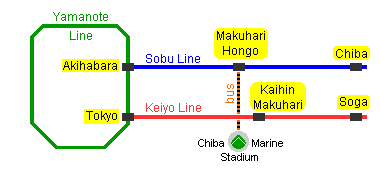
You can also get to Marine Stadium by taking the JR Keiyo Line from Tokyo Station to Kaihin Makuhari Station. It's about a thirty-five minute ride. Once you get to Kaihin Makuhari, just follow the signs or the map on this page. You can also go out the west exit and on your left you'll see an information booth.
But before you leave the station, you might want to pick up a few snacks and beverages at the JC convenience store (opposite the ticket machines).
Around Chiba Marine Stadium:
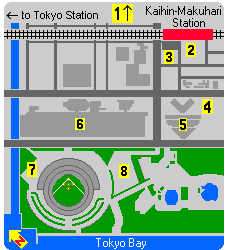
- To Makuhari-Hongo Station (ten blocks NE)
- Information booth
- Plena Makuhari (food court)
- Hotels
- Makuhari Prince Hotel
- Makuhari Messe Convention Center
- Chiba Marine Stadium
- Parking
Just opposite the station, you can stop by Plena Makuhari, essentially a five-story food court. There, you will find a Subway Sandwiches outlet, Lotteria, and other fast-food shops. On the upper floors, the quality and price of food goes up.
Incidentally, Marine Stadium offers the usual selection of Japanese and Western food, including ramen, soba, hamburgers, hot dogs, corn dogs, and popcorn. You can also get soft-drinks, tea, beer, sake and other potables. If you find this selection disappointing, you may bring your own snacks and drinks with you to the game.
Hotels: Since Marine Stadium is only thirty-minutes from central Tokyo, you may not need a hotel unless you are from out-of-town. At the top end, there is the luxurious five-star Makuhari Prince Hotel facing Tokyo Bay. Behind this tower, you will find several smaller hotels.
If you happen to find romance during the seven inning stretch, take the municipal bus to Makuhari-Hongo. About five blocks south-west of the station, you will find a cluster of love hotels (one shaped like a flying saucer).
Rooms in most of these romantic hideaways run from about 8,000 to 12,000 yen for an overnight stay, or 4,000 to 6,000 for a two hour rest. Assuming you're not too occupied "resting" most rooms come with TV (don't expect to see the Disney channel), VCR, satellite radio box, and possibly a karaoke or Nintendo machine.
Skymark Stadium
[No longer the home of the Orix Buffaloes (formerly Orix BlueWave), it is still used for a number of games each season.]
Unlike most other Japanese ballparks, Green Stadium offers some parking, so in theory it is possible to drive there. But since the spaces fill up quickly, it's probably a better idea to go by train.

Located next to the ball park, Sogo Undo Koen Station lies on the Seishin Subway Line, four stops from Shin-Nagata Station.
Around Green Stadium Kobe:
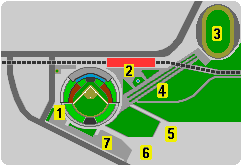
- Green Stadium
- Sogo Undo Koen Subway Station
- Univa Memorial Field
- Ticket booth (for future games) and gift shop
- Outdoor amphitheatre
- Green Arena
- Parking
Tickets are available outside the ballpark, and there is a booth nearby which sells merchandise and tickets to upcoming games.
Part of a larger sports complex, Green Stadium lies near the Univa Memorial Track Field, Green Arena Kobe and Sogo Undo Koen (Park). As far as restaurants and convenience stores, the area is pretty barren, so it's a good idea to pick up your snacks and beverages before you get on the train to Green Stadium.
Kyocera Dome
If you prefer the road less traveled, the best way to get to Osaka Dome is to take the Subway Chuo Line to Kujo Station. It's a few minutes farther from the dome than than other routes, and the walk is rather bland, but you'll likely avoid crowded sidewalks.
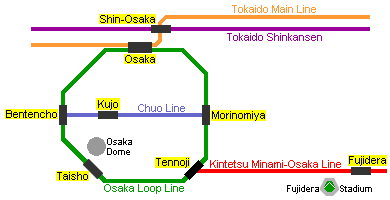
Recently [as of 1999] completed, there's a new way to get to Osaka Dome. The Nagahori-Tsurumi Ryokuchi Subway Line now connects to Osaka Dome-Mae Chiosaki Station, just one block east of the ballpark.
Through that one block, you'll pass through the Padou entertainment district, part of "Osaka Dome City," that contains a bowling alley, game center, a donut shop, a Subway Sandwiches franchise, the Buffaloes gift shop, and a few Italian restaurants. If you have any money left after that one-block trek, you can purchase your tickets at the front of the dome.
Around Osaka Dome:
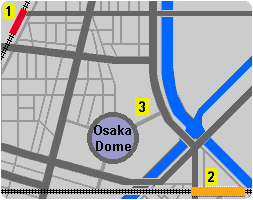
- Kujo Station (Chuo Line)
- Taisho Station (JR Osaka Loop Line)
- Osaka Dome City
While Chiosaki Station may be nearest to the ballpark, the subway line on which it rests may not be the most convenient to travel since it bypasses many of the city's hub stations. It does, however, connect with Taisho Station on the JR Osaka Loop Line, the rail beltway that encircles central Osaka.
But if you are already at Taisho station, there's really no need to take the subway, since the Osaka Dome is only a five minute walk away. Just look for the glimmering silver spaceship on the horizon and walk that way.
While the Buffaloes moved into Osaka Dome in 1997, they still play a few games every year at their old ballpark, Fujiidera Stadium. Just follow the subway map (top of this page). The ballpark is about a two minute walk from the station.
To reach Seibu Dome, take the Seibu Shinjuku line from Shinjuku Station. After a thirty minute ride, get off at Tokorozawa Station. Look for the platform leading to Seibu Kyujo-mae Station, and get on the next train bearing folks wearing light blue Lions caps.
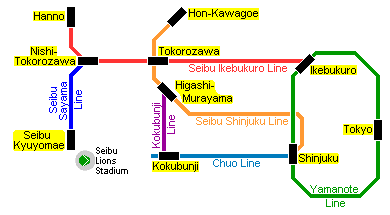
After another five minutes, you will arrive at Seibu Kyujo-mae. Walk toward the front of the platform and out the ticket gates. Before proceeding any further, it might be a good idea to purchase your return ticket. After the game, the lines can be quite long.
Around Seibu Dome:
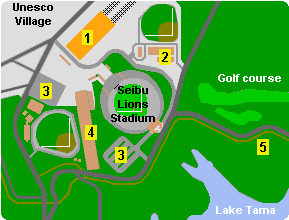
- Seibu Kyujo-mae Station
- Tennis courts
- Parking
- Indoor skiing
- Bike trail
From the station, to your left you can see the back of the stadium scoreboard. Straight ahead from the ticket gates, you can purchase your game tickets. If you have time, you can wander around the booths outside the station, purchase food, drinks, and Lions merchandise.
While you are allowed to bring your own food and beverages to the game, you won't find any fast food restaurants. There is a convenience store, however, about a hundred meters west of Seibu Kyujo-mae Station.
Seibu Dome is actually part of a larger entertainment complex. Nearby, you'll find an amusement park with rides, a golf course, two practice baseball fields, an indoor ski slope, and other expensive diversions. If you don't mind letting your family eat rice and gruel for the rest of the month, bring your cash and blow it all in one day. It won't be difficult.
If you need a hotel, look around Tokorozawa. Rates should be somewhat cheaper than rooms in Central Tokyo.
This work is licensed under a Creative Commons License.
Some rights reserved.